![]()
![]()
![]()
Use LEFT and RIGHT arrow keys to navigate between flashcards;
Use UP and DOWN arrow keys to flip the card;
H to show hint;
A reads text to speech;
140 Cards in this Set
- Front
- Back
|
The study of the functions of an organism and its constituent parts |
Physiology |
|
|
Name 3 branches of physiology. |
Immunology Respiratory Renal Exercise Molecular |
|
|
What are the 6 levels of structural organization? |
1) Chemical level (atoms, molecules) 2) cellular 3) tissue 4) organ 5) system 6) organism |
|
|
Components and functions of the integumentary system. |
- skin, hair, fingernails, toenails, sweat glands, oil glands - protects body, regs temp, some waste elim - helps make vitamin d - touch, pain, warmth, cold - stores fat and provides insulation |
|
|
Components and functions of skeletal system |
- bones, joints, cartilages - supports and protects - area for muscle to attach - aids body movement - house cells that produce blood cells - stores minerals and lipids |
|
|
Components and functions of the muscular system |
- muscle usually attached to bone, smooth, and cardiac - body movements, posture - produces heat |
|
|
Components and functions of nervous system |
- makes action potentials to reg body - detects changes - Interprets changes - responds by causing muscular contractions or glandular secretions |
|
|
Components and functions of endocrine system |
- hormone producing glands and cells, pancreas, ovaries, testes - regulates body activities by releasing hormones transported in blood |
|
|
Components and functions of cardiovascular system |
- blood, heart, and blood vessels - heart pumps blood through blood vessels - blood carries o2 and nutrients to cells and CO2 and waste away - helps reg acid base balance, temp, and water - blood defends against disease and helps repair damaged blood vessels |
|
|
Components and functions of lymphoid system and immunity |
- lymphatic fluid, spleen, thymus, lymph node, tonsils, immune cells - returns proteins and fluid to blood - carries lipids from gastrointestinal tract to blood - contains sites of maturation and proliferation of B cells and t cells that protect against disease causing microbes |
|
|
Components and functions of respiratory system (3 functions) |
- lungs, pharynx, larynx, trachea, bronchial tubes - transfers oxygen from inhaled to air to blood and carbon dioxide from blood to exhaled air - helps regulate acid-base balance of body fluids - air flowing out of lungs through vocal cords produce sounds |
|
|
Digestive system components and functions |
- mouth, pharynx, esophagus, stomach, intestines, anus, salivary glands, liver, gallbladder, pancreas - physical and chemical breakdown of food - absorbs nutrients - eliminate solid waste |
|
|
Components and functions of the urinary system |
- kidneys, ureters, urinary bladder, urethra - produces, stores, and eliminates urine - eliminates waste and regulates volume and chemical comp of blood - helps maintain acid base balance of body fluids - maintains bodies mineral balance - helps regulate production of red blood cells |
|
|
Components and functions of reproductive system |
- gonads and associated organs - gonads produce gametes that unite to form a new organism - also release hormones that regulate reproduction and other body processes |
|
|
What are the basic components of the feedback loop (6)? |
- stimulus - controlled condition - receptors - control center - effectors - response that alters the controlled condition |
|
|
Reverses a change in a controlled condition |
Negative feedback |
|
|
Strengthen or reinforce a change in one of the body's controlled conditions |
Positive feedback |
|
|
Strengthen or reinforce a change in one of the body's controlled conditions |
Positive feedback |
|
|
Maintenance of relatively stable conditions in the body's internal environment |
Homeostasis |
|
|
When several components work together to accomplish a particular function |
Integration |
|
|
Explain how the body works by indicating the mechanisms that are involved |
Mechanism of action |
|
|
Cells of the body must communicate with one another in order for the body to function |
Communication |
|
|
What is the phospholipid bilayer composed of? |
Two back to back layers made up of three types of lipids - 75% phospholipid - 20% cholesterol - 5% glycolipid |
|
|
Transports a specific substance across membrane by undergoing a change in shape. For example, amino acids, needed to synthesize new proteins enter body cells via __________. __________ proteins are also known as transporters. |
Carrier (integral) protein |
|
|
Forms a pore through which a specific ion can flow to get across membrane. Most plasma membranes include specific channels for several common ions |
Ion channel (integral) |
|
|
Recognizes specifically ligand and altered cells function in some way. For example, antideretic hormone binds to receptors in the kidneys and changes the water permeability of certain plasma membranes |
Receptor (integral) |
|
|
Catalyzes reaction inside or outside cell. For example, lactase protruding from epithelial cells lining your small intestine splits the disaccharide lactose in the milk you drink. |
Enzyme (integral and peripheral) |
|
|
Anchors filaments inside and outside the plasma membrane, providing structural stability and shape for the cell. May also participate in movement of the cell or link to cells together. |
Linker (integral and peripheral) |
|
|
Distinguishes yourselves from anyone else's unless you are a twin. An important class of such markers are the major histo compatibility proteins |
Cell identity marker glycoprotein |
|
|
Describe cytosol. |
- site of chemical reactions - 55% total cell volume -mostly water - Ions, glucose, amino acids, fatty acids, protein |
|
|
Describe ribosomes function |
Site of protein synthesis - free = synthesize proteins used in cytoplasm - bound = synthesize proteins used for export from the cell, insertion into plasma membrane or for specific organelles |
|
|
Describe function of endoplasmic reticulum |
- network of membranes in the form of flattened sacs of tubules - rough=site of protein synthesis -smooth=extends from rough, site of lipids synthesis |
|
|
Describe functions of Golgi complex |
Further modifies proteins made by the rough ER |
|
|
Describe function of the mitochondria |
- ATP - self replicate - own DNA |
|
|
Describe the functions lysosomes |
- contain digestive enzymes that digest many substrates - contain transporters that move the final products of digestion - recycle worn out cell structures |
|
|
Describe functions of peroxisomes |
- microbodies - smaller than lysosomes - contains oxidases that metabolize amino acids and fatty acids - oxidized toxic substances such as alcohol |
|
|
Describe the function of proteasomes |
- contain proteases - degrades unwanted or damaged proteins that are in the cytosol - important for cell function and metabolic control |
|
|
Grab the function and components of cytoskeleton |
- network a protein filaments that extend through the cytosol, provide structural framework, aids in movement - 3 types: microfilaments, intermediate filaments, microtubules |
|
|
Describe microfilaments |
- thinnest elements, actin - prevalent at edge of cell - functions: generate movement, provide mechanical support for cell, form microvilli |
|
|
Describe intermediate filaments |
- functions: stress places, health position organelles, attach cells together |
|
|
Describe microtubules |
- largest, composed of mainly tubulin - functions: determine cell shape, movement of organelles, cilia and flagella |
|
|
Describe centrosome functions and components |
- organizes microtubules - located near nucleus - a pair of centrioles, pericentriolar material |
|
|
Describe flagella |
- move an entire cell - long |
|
|
Describe cilia |
Numerous, short, hair like projections that extend from the surface of certain types of cells |
|
|
Describe the nucleus |
Houses most DNA of the cell, DNA contains genes |
|
|
Describe the nuclear envelope |
Double membrane that surrounds nucleus, both layers are like the plasma membrane, continuous with the rough ER |
|
|
Dark staining within the nucleus, cluster of dna, RNA and proteins, site of rRna synthesis |
Nucleolus |
|
|
Describe the two ways of packing DNA |
- non dividing cell: DNA associated with proteins, packed as chromatin - dividing cell: chromosome, ultra condensed chromatin, sister chromatids |
|
|
A group of cells that usually have a common embryonic origin and function together to carry out specialized activities |
A tissue |
|
|
What are the four basic types of tissues? |
1) epithelial tissue - covering and lining 2) connective tissue - protection and support 3) muscular tissue - contraction and generation of force 4) nervous tissue - detection, relay and processing center |
|
|
What are the general features of epithelial tissue? |
- arranged in sheets, densely packed - cell junctions - attached to a basement membrane - form glands |
|

What are the classifications of these epithelial tissues? |
Simple, pseudostratified, stratified |
|

Describe the simple squamous epithelium description, location and function |
Description: single layer of fat cells located near nucleus Location: lines and the CV and lymphatic system, serous membrane in abdominal and thoracic cavities, air sacs of lungs, kidneys Function: sites of filtration, or diffusion, and secretion in serous membranes |
|
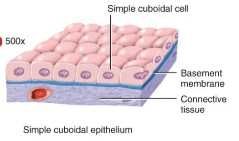
Describe simple cuboidal epithelium |
Single layer of cube shaped cells |
|
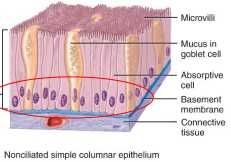
Describe nonciliated simple columnar epithelium description, location and function |
Description: oval nuclei near base of cells, contains commoner epithelial cells with microvilli and goblet cells Location: GI tract, ducts of glands and gallbladder Function: secretion and absorption, mucus loot crates lining of digestive respiratory and reproductive tracts and most severinary tract, helps prevent destruction of stomach lining |
|
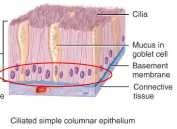
Ciliated simple columnar epithelium description |
Single layer of ciliated column-like cells with oval nuclei near place of cells Goblet cells usually interspersed |
|
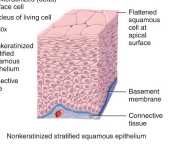
Description of stratified squamous epithelium |
Contains two or more layers of cells, several layers deep are squamous, deeper cells are cuboidal and columnar Two types: keratinized stratified squamous epithelium, and nonkeratinized stratified squamous epithelium |
|
|
A single cell or mass of epithelium cells adapted for secretion |
Gland |
|
|
Enter the interstitial fluid and diffuse into the bloodstream. Hormones regulate mini metabolic and physiological activities to maintain homeostasis. |
Endocrine gland |
|
|
Enter ducts that empty onto the surface of lining/covering epithelium. Produce substances such as sweat, oil, ear wax, saliva etc |
Exocrine glands |
|
|
The most abundant and widely distributed tissue. A variety of functions including buying tissues together, supports, strengthens, protects and insulates internal organs, and major transport system within body |
Connective |
|
|
What are the two basic elements of connective tissue |
1) Cells 2) extracellular Matrix Connective tissue cells do not have any free surfaces, connective tissue is highly vascularized and has nerve supply |
|
|
Name the tissue that specializes in contractions and it's three types |
Muscle - skeletal, smooth, cardiac |
|
|
Name the tissue that the text and responds to changes in the body's external and internal environment and the two things it is made of |
Nervous - neurons, neuroglia |
|
|
Specialized components within the plasma membrane that holds cells together. Name five types. |
Cell junctions - tight junctions, adherens, desmosomes, hemidesmosomes, Gap junctions |
|
|
Consists of web-like strands of transmembrane proteins that fuse together the outer surfaces of adjustment plasma membranes to seal off passageways between adjacent cells |
Tight junctions |
|
|
Contain plaque, a dense layer of proteins on the inside of the plasma membrane that attaches to both the membrane proteins and to microfilaments of the cytoskeleton |
Adherens |
|
|
Contains plaque and have transmembrane glycoproteins (cadherins) that extend to the intracellular space between adjacent cell membranes and attach cells to one another |
Desmosomes |
|
|
Resemble desmosomes but they do not link adjacent cells, instead, the anchor cells to the basement membrane. The name arises from the fact that they look like half a desmosome |
Hemidesmosomes |
|
|
Membrane proteins called connexins form tiny fluid fill tunnels called connexions that connect neighboring cells, and allow ions and other small molecules to diffuse between these cells |
Gap Junctions |
|
|
Difference in the concentration of a chemical from one place to another, such as from inside to the outside of the plasma membrane |
Concentration gradient |
|
|
A difference in electrical charges between two regions, such as across the plasma membrane |
Electrical gradient |
|
|
Both electrical and chemical forces act on ions |
Electrochemical gradients |
|
|
A substance moves across them plasma membrane without any energy from the cell |
Passive transport - downhill concentration or electrochemical gradient |
|
|
Cellular energy, such as atp, is used to move a substance across the plasma membrane |
Active transport - against concentration or electrochemical gradient |
|
|
Random mixing a particles from one location to another because of the particles is kinetic energy |
Diffusion |
|
|
Name five factors that influence diffusion |
Steepness of the concentration gradient, temperature, mass of the diffusing particle, surface area, diffusion distance |
|
|
Passive process in which solutes move freely through the lipid bilayer of the plasma membranes of cells without the help of membrane transport proteins |
Simple diffusion |
|
|
What are the three types of passive diffusion? |
Simple diffusion, facilitated diffusion, osmosis |
|
|
What are the two mechanisms of facilitated diffusion? |
Channel mediated, carrier mediated |
|
|
Solute moves down it's concentration or electrochemical gradient across the lipid bilayer through a membrane channel |
Channel mediated |
|
|
Used to move a solute down its concentration or electrochemical gradient across the plasma membrane. Not a continuous poor, solute binds to carrier. |
Carrier mediated |
|
|
Name the four properties carrier mediated transport exhibits. |
Specificity, affinity, saturation (transport maximum), competition |
|
|
Involves the net movement of solvent through a selectively permeable membrane. Occurs via aquaporins and simple diffusion. |
Osmosis |
|
|
Pressure exerted by a liquid |
Hydrostatic pressure |
|
|
The amount of pressure needed to completely stop the osmotic movement of water |
Osmotic pressure |
|
|
A measure of the total number of dissolved particles per liter of solution |
Osmolarity |
|
|
Effect that osmolarity has on a cell shape |
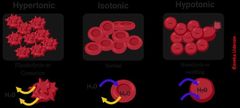
Tonicity |
|
|
Describe primary active transport versus secondary active transport |
Primary uses ATP Secondary uses energy stored in electric chemical gradient to drive other solutes |
|
|
Energy derived from hydrolysis of ATP changes the shape of a carrier protein to move a solute across a plasma membrane against its concentration or electrochemical gradient |
Primary active transport |
|
|
Energy stored in the electric chemical gradient of an ion is used as energy to drive other solutes across the plasma membrane against their own concentration or electrochemical gradients |
Secondary active transport |
|
|
A type of endocytosis that is highly selective, cells take up specifically ligands, ligand binds to a specific plasma membrane receptor and vesicle forms |
Receptor mediated endocytosis |
|
|
A form of endocytosis in which the cell engulfs a large solid particle such as bacterium |
Phagocytosis |
|
|
AKA pinocytosis, a form of endocytosis where tiny bits of extracellular fluid are taken up |
Bulk phase endocytosis |
|
|
Used to release materials from a cell |
Exocytosis |
|
|
Movement of solutes across epithelial cells |
Transepothelial transport |
|
|
When a solute moves from the Lumen of an organ to the bloodstream |
Absorption |
|
|
When a solute moves from the bloodstream to the Lumen of an organ |
Secretion |
|
|
Transport using vesicles to move a substance successively into, across, and out of a cell |
Transcytosis |
|
|
Describe the sensory function of the nervous system |
Sensory receptors detect external or internal stimuli and relay sensory information to the brain and spinal cord for integration |
|
|
Describe the integration function of the nervous system |
CNS analyzes sensory information, and makes decisions for appropriate responses |
|
|
Describe the motor function of the nervous system |
Motor information is conveyed from the CNS through the cranial and spinal nerves of the pns to appropriate effectors, muscles and glands |
|
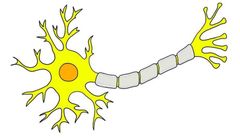
Label: cell body, dendrites, axon |
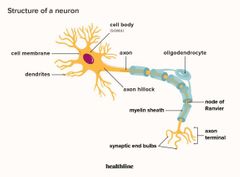
|
|
|
The point of contact with axons of other cells |
Dendrites |
|
|
Juncture of the soma and axon where the action potential begins |
Axon Hillcock |
|
|
Branches of an axon |
Axon collaterals |
|
|
And branches of an axon |
Teleodendria |
|
|
Not at the tip of an axon that conveys information to other neurons, also called an end foot |
Terminal button |
|
|
Gap between one neuron and another neuron, usually between an end foot of an axon of one neuron and a dendritic spine of another neuron |
Synapse |
|
|
A type of neuron that carries information from the sensory receptors in or on the body to the spinal cord |
Sensory neuron |
|
|
Associates with sensory and motor activity within the central nervous system |
Interneurons - stellate, pyramidal, Purkinje |
|
|
Send signals from the brain and spinal cord two muscles, reside in the lower brainstem and spinal cord |
Motor neuron |
|
|
What are the five types of glial cells |
Ependymal cell, astrocyte, microglial cell, ogliodendroglial cell, Schwann cell |
|
|
Small ovoid, secretes cerebrospinal fluid |
Ependymal cell |
|
|
Star-shaped, contributes to neuronal nutrition, support, and repair, contributes to forming blood-brain barrier and to healing scarring after injury |
Astrocyte |
|
|
Small, derived from blood, defensive function to remove dead tissue |
Microglial cell |
|
|
Form myelin around CNS axons in brain and spinal cord |
Oligodendroglial cell |
|
|
Wraps around peripheral nerves to form myelin |
Schwann cell |
|
|
Name some of the functions of the myelin sheath |
Electrical insulation, found in both the CNS and pns, nodes of ranvier, makes up white matter |
|
|
Regeneration in the pns occurs if the cell body is still intact and if the Schwann cell remains active what are the four steps of regeneration? |
1) peripheral axon is cut axon dies 2) Schwan sells shrink then divide, forming glial cells along axons former path 3) neurons sends out axon sprouts one of which finds the Schwan cell path and becomes a new Axon 4) schwann cells envelope the new Axon forming new myelin |
|
|
Does regeneration occur in the CNS |
Little to no regeneration Because of inhibitory proteins released by neuroglia, absence of stimulating cues, scar tissue formation, CNS damage is permanent |
|
|
Have Gates that randomly alternate between open and close positions, a type of ion Channel |
Leak Channel |
|
|
A type of ion channel that opens or closes in response to a specific ligand stimulus |
Ligand-gated channel |
|
|
A type of ion Channel that opens or closes in response to a mechanical stimulation could be forms of touch pressure tissue stretching and vibration |
Mechanically gated channels |
|
|
A type of ion channel that opens in response to a change in membrane potential |
Voltage gated Channel |
|
|
Name the three functions of ion channels |
- ions can flow - resting membrane potential changes - allows for electrical communication |
|
|
The point at which there is no net flow of ion. Chemical gradient and electrical gradient are equal and opposite. |
Equilibrium potential |
|
|
Describe subthreshold stimulus and suprathreshold stimulus |
Subthreshold = not strong enough Suprathreshold = stronger than necessary even though action potential itself is all or not Threshold is 55 mV |
|
|
What are the three phases of action potential? |
Depolarizing, repolarizing, after hypopolarizing |
|
|
The rising phase of the action potential. This occurs up until the membrane potential goes up to 30 mV |
Depolarizing phase |
|
|
The falling phase of the action potential. This occurs until the main brain potential gets back to rest -70 mV |
Repolarizing phase |
|
|
After resting membrane potential is reestablished, the undershoot that is observed. Typically goes down to -90 MV |
After hyperpolarizing |
|
|
What are the (3) factors that affect propagation speed? |
1) axon diameter - larger diameter axons propagate APs faster 2) amount of myelination- Milan increases speed of AP propagation 3) temperature - higher temp increases speed of AP propagation |
|
|
The point at which one neuron communicates with another neuron or Target tissue |
Synapse |
|
|
A neurotransmitter released results in a hyperpolarization of the postsynaptic membrane |
Inhibitory postsynaptic potential |
|
|
Neurotransmitter release results in a depolarization of the post synaptic membrane |
Excitatory postsynaptic potential |
|
|
What happens if the next summation of epsps and IPSPs is a depolarization that reaches threshold? |
An action potential occurs at the trigger zone of the post synaptic neuron |
|
|
A type of receptor that function as a ligand gated Channel |
Ionotropic receptor |
|
|
A type of receptor that function through a g protein |
Metabotropic receptor |
|
|
Regulates neurotransmitter release, leading to either increased or decreased release |
Presynaptic modulation |

